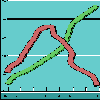|
By : Jim Pinto, Abundances and scarcities play out in a spiral of reciprocity, with each producing its opposite in the cycles of economic advance. The inflection point between abundance and scarcity is where significant growth and wealth is generated for leaders who utilizes knowledge and creativity to manipulate the future abundance while it is still a scarcity. For industrial automation, several new inflection points will arrive in the next couple of decades. Here, I suggest my favorite possibilities. Industrial Controls Intelligence & Plant Systems Report, December 2000 |

Technology drives progressTechnology improves productivity in 5 ways : reduces labor, optimizes use of raw materials, saves energy and waste, improves quality and saves time. When technology is proprietary, it has value and generates wealth. When the knowledge is spread widely, the products become commodities - available from several sources with marginally different features and benefits . The lowest cost producer usually wins market-share.Forgive the recitation of fundamentals, but I am making a point that relates to our previous topics on Automation in Decline (September 2000) and Companies in Trouble (October 2000) that generated a lot of debate and discussion. On that theme, rather than simply being the reporter of recession, I would prefer to present a path to renewed industrial automation success. For this, we must review the possibilities within a larger perspective. Industrial automation is becoming a commodityA few decades ago, industrial automation involved a lot of proprietary knowledge, which generated significant value for the purveyors of that knowledge. Industrial automation products were an essential and proprietary ingredient in factories and process plants. At the turn of the century, a lot of the proprietary content has melted away through rapid and widespread dissemination of the information in the global arena. Automation knowledge that produces quality goods at low cost has now become a commodity - everyone knows how to do it. In many cases, the western world chased cheap labor in the Far East and educated the locals with their knowledge as part of the project - shortsightedly frittering away the value.To remain “proprietary” in this day and age, developments must progress in months, rather than years, or value degenerates quickly. The benefits generated by proprietary knowledge must be substantial, to get beyond the competitive noise level. Features that translate into marginal gains do not command much beyond commodity pricing. The features and functions of a PLC and DCS are easily copied and the cost reduces to quality manufacture of commodity products with the lowest overhead. Software is also quickly and easily copied - if not directly, then at least through availability of functional equivalents that can be developed quickly and cheaply in countries like India, which have rapidly become centers of the software universe. The computer age is overGeorge Gilder’s his new book Telecosm presents a thought-provoking discussion, starting with : “The computer age is over.” The PC revolution, and the silicon technology that triggered it, drove significant growth in the past decade - but these technologies have now become commodities. Gilder insists that Intel and Microsoft are simply becoming icons of a bygone age - they no longer shape the future.Intel cannot continue to leverage its power through producing giant chips in multi-billion-dollar factories, because in the future computer intelligence will be disseminated in tiny intelligent chips with wireless connections. The bloated code of Microsoft will not be brought down by another software giant, but will be circumvented by software that is part of every product and appliance. People will not use software - it will simply be part of the things they use. Of course, the microchip and the computer will still retain their tremendous importance, in ways similar to steel mills and power plants. They have past their peak and now simply become part of the platform that is giving birth to new technologies that are transforming human economies and cultures, faster and more drastically than ever before. Abundance and ScarcityIn the industrial age, power (steam, coal, oil and electricity) was available in abundance. In the past century, the cost of a kilowatt hour equivalent dropped from hundreds of dollars to about 5c and it continues to decline at about 2 percent per year. De-regulation changes it from being a “scarce commodity” (a paradox of words) that only the power company monopoly could provide and gives it the status of a true commodity. While there may be temporary price surges, de-regulation will inevitably cause eventual pricing to decline to a commodity level.A typical PC uses about a thousand kW hours per year. The billion computers which are expected to be connected to the Internet over the next five years, together with peripherals and hundreds of billions of embedded chips, will consume as much electricity as the entire US economy does today. So, power - once an “abundance” - will become a “scarcity”. During the past 30 years, the cost of a transistor dropped from about $10 to a few millionths of a cent, and continues to decline (Moore’s Law) at about 66% a year. Processing MIPS (millions of instructions per second) that cost several millions of dollars sell for less than a buck today. And we utilize that abundance not only in computers and workstations, but also in video games and music synthesizers. In short, the defining abundances of the past few decades have been silicon and power. People used those abundances to relieve the scarcities. In what Gilder defines as the “macrocosm”, they use power to replace horses and slaves, while in the “microcosm” they use silicon intelligence to replace human intelligence. Defining abundances and scarcities mark every new era. And there is a natural overlap - the successes of one era spur and enable the successes of the next. The plentitude of the agricultural age loosed resources for the industrial revolution, while that in turn served as a platform for the computer revolution. The sons of the industrialists went off to study technology and came back to start new computer or software companies, which now in turn are giving birth to the new era of information connectivity. The Inflection pointOver the years, people always have felt that scarcity will ultimately prevail over abundance. However, Necessity (the mother of invention) turns scarcity into abundance. Abundances and scarcities play out in a spiral of reciprocity, with each producing its opposite in the cycles of economic advance.A scarcity finds meaning and value in the future abundance that it causes - and that is the inflection point where significant growth and wealth is generated for leaders who utilizes knowledge and creativity to manipulate the future abundance while it is still a scarcity. Industrial automation inflection pointsFor industrial automation, several new inflection points will arrive in the next couple of decades. Let me suggest my favorite possibilities :MEMS : Micro-electromechanical systemsMEMSwill bring revolutionary improvements utilizing semiconductor fabrication techniques to produce miniature turbines, motors, gears, moving mirrors and sensors. MEMS will be the sensors, actuators and displays for the digital devices of the future, bringing the analog and digital worlds closer together than ever before.NanotechnologyPhysical production will become obsolete as nanotechnology enables the building of products at the atomic level. Nanotechnology promises more precisely machined moving parts, which means less wear. Materials and products will be built to order, with flawless internal structures that make them stronger and lighter. Electronics will get smaller and hence faster (the speed of light limitation). As things continue to shrink, quantum effects that reign at the atomic scale will lead to computing performance beyond today's wildest dreams.Complex-adaptive-systemsThe peer to peer revolution, championed by Napster (people downloading music from each others computers over the Internet) will have a significant impact on future information exchange and processing structures. The central control hierarchies of the past will give way to new self-organizing peer-to-peer networks, where intelligence resides directly in the sensors and actuators, eliminating large, complex and ineffective centralized control systems. By these standards, today’s PLC and PC-based controls and software will seem ineffective, expensive and even archaic.

|
Return to Index of all JimPinto Writings

 Return to JimPinto.com HomePage
Return to JimPinto.com HomePage
If you have ideas or suggestions to improve this site, contact: webmaster@jimpinto.com
Copyright 2000 : Jim Pinto, San Diego, CA, USA
